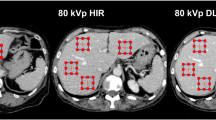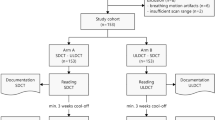Abstract
Background
We determined staff radiation dose during rest and stress rubidium 82 myocardial perfusion positron emission tomography (PET) imaging.
Methods and Results
Patients received 1587 ± 163 MBq (42.9 ± 4.4 mCi) Rb-82 during rest or pharmacologic stress. A pressurized ion chamber was used to monitor radiation exposure in 50 examinations. For comparison, staff exposure during pharmacologic stress in 20 other patients receiving 1204 ± 55.5 MBq (32.54 ± 1.5 mCi) technetium 99m 2-methoxy isobutyl isonitrile (MIBI) was measured. For Rb-82 infusion and PET acquisition, the mean dose was 0.45 ± 0.25 μSv (0.045 ± 0.025 mrem). Exposure for routine stress testing at variable distances from the patient was equivalent to background. Similar exposure for pharmacologic stress testing through 7 minutes after injection of Tc-99m MIBI at variable distances was 1.075 ± 0.32 μSv (0.108 ± 0.03 mrem). However, exposure for stress tests starting 7 minutes after Rb-82 infusion at 0.5 m was estimated at 0.4 μSv (0.04 mrem). To determine the potential radiation dose for those responding to a medical emergency or otherwise in close proximity to a patient, we measured the mean cumulative dose at 0.5 m from 0 to 7 minutes of Rb-82 infusion, which resulted in 19.1 ± 5.8 μSv (1.9 ± 0.58 mrem).
Conclusions
Radiation doses for all tasks during routine Rb-82 stress-rest PET are lower than measured Tc-99m MIBI values. However, the radiation dose in close proximity to the patient during or immediately after Rb-82 infusion can be considerably higher, underscoring the need for strict attention to source distance and contact times.
Similar content being viewed by others
References
Machac J. PET myocardial perfusion imaging. Am J Card Imaging 1992;6:42–58.
Bateman TM. Cardiac positron emission tomography and the role of adenosine pharmacologic stress. Am J Cardiol 2004;94(Suppl):19D-25D.
Brown TF, Yasillo NJ. Radiation safety considerations for PET centers. J Nucl Med Technol 1997;25:98–102.
Chiesa C, De Sanctis V, Crippa F, Schiavini M, Fragiola CE, Bogni A, et al. Radiation dose to technicians per nuclear medicine procedure: comparison between technetium-99m, gallium-67, and iodine-131 radiotracers and fluorine-18 fluorodeoxyglucose. Eur J Nucl Med 1997;24:1380–9.
Benatar NA, Cronin BF, O’Doherty MJ. Radiation dose rates from patients undergoing PET: implications for technologists and waiting areas. Eur J Nucl Med 2000;27:583–9.
Wu TH, Liu RS, Chong NS, Tsai CS, Lee JS. Evaluation of equivalent dose to working staff with oxygen-15-water in positron emission tomographic studies. Appl Radiat Isot 2002;53:463–8.
Biran T, Weininger J, Malchi S, Marciano R, Chisin R. Measurements of occupational exposure for a technologist performing 18F FDG PET scans. Health Phys 2004;87:539–44.
Roberts FO, Gunawardana DH, Pathmaraj K, Wallace A, U PL, Mi T, et al. Radiation dose to PET technologists and strategies to lower occupational exposure. J Nucl Med Technol 2005;33:44–7.
Anderson JA, Mathews D. Site planning and radiation safety in the PET facility. Proceedings of the 44th Annual American Association of Physicists in Medicine; 2002 Jul 14–18; Montreal, Quebec, Canada.
Methé BM. Shielding design for a PET imaging suite: a case study. Health Phys 2003;84(Suppl):S83–8.
Limacher MC, Douglas PS, Germano G, Laskey WK, Lindsay BD, McKetty MH, et al. ACC expert consensus document. Radiation safety in the practice of cardiology. American College of Cardiology. J Am Coll Cardiol 1998;31:892–913.
1990 Recommendations of the International Commission on Radiological Protection. Ann ICRP 1991;21:1-201.
56 Federal Register 23396 (1991) (codified at 10 CFR §20.1201).
NUREG-SR 1556, volume 9. Program-specific guidance about medical use licenses. US Nuclear Regulatory Commission: Washington, DC; 1998.
Ranhosky A, Kempthome-Rawson J. The safety of intravenous dipyridamole thallium myocardial perfusion imaging. Intravenous Dipyridamole Thallium Imaging Study Group. Circulation 1990;81:1205–9.
Smart R. Task-specific monitoring of nuclear medicine technologists’ radiation exposure. Radiat Prot Dosimetry 2004; 109:201–9 .
Clarke EA, Notghi A, Harding LK. Are MIBI/tetrofosmin heart studies a potential radiation hazard to technologists? Nucl Med Commun 1997;18:574–7.
Author information
Authors and Affiliations
Corresponding author
Additional information
AR Schleipman is a recipient of a research grant funded by the Society of Nuclear Medicine Technologist Section Professional Development and Education Fund (SNM-PDEF), which partially supported this work.
An erratum to this article is available at http://dx.doi.org/10.1016/j.nuclcard.2006.06.127.
Rights and permissions
About this article
Cite this article
Schleipman, A.R., Castronovo, F.P., Carli, M.F.D. et al. Occupational radiation dose associated with Rb-82 myocardial perfusion positron emission tomography imaging. J Nucl Cardiol 13, 378–384 (2006). https://doi.org/10.1016/j.nuclcard.2006.03.001
Received:
Accepted:
Issue Date:
DOI: https://doi.org/10.1016/j.nuclcard.2006.03.001




